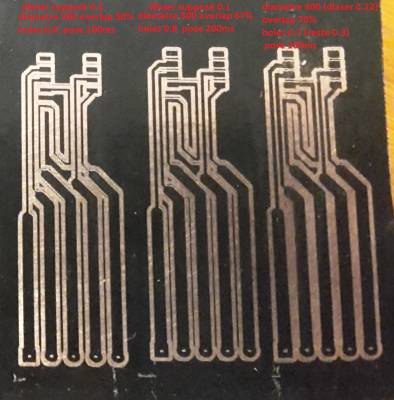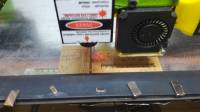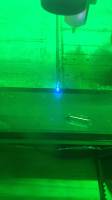Outils pour utilisateurs
Table des matières
Index
ROUTAGE
- Plus la fréquence de travail est grande moins les pistes doivent être longues, de préférences le plus large possible pour avoir une inductance équivalente la plus faible possible.
- Faire un plan de masse afin d'avoir la meilleure équipotentielle, raccorder en étoile les masses en séparant d'un coté les masses dites de signal, et les masses drainant de forts courants.
- Les masses ramenant les forts courants seront acheminées au plus près de la connexion de masse à l'entrée de la carte. Sur le plan de masse seront de préférence raccordés toutes les masses “signaux”. Le but est que la masse de tout le monde “bouge” de la même manière sans déséquilibre important, sinon gare aux choses bizarres.
- Éviter les angles droits au niveau des pistes de liaisons.
- Soigner le routage des condensateurs de découplages en réduisant au maximum la surface décrite par les raccordements du condensateur aux liaisons alim, ainsi que les longueurs des fils.
En clair dans le cas d'un simple face, les 2 fils seront amenés en parallèle avec un faible écart entre eux. Dans le cas du double face, un fil coté composant, l'autre coté soudures juste en dessous suivant le même chemin.
Perclo
The chloride in bags is obtained by re-crystallising liquid; to obtain a solution at 36° B, dilute 400 g of crystals in 0.75 litres of water; this will give 0.9 litres
il me reste 100g ⇒ 250ml de solution ⇒ n'en faire que la moitié cela suiffe pour en avoir 2mm au fond de la bassine
gravure , methode imprimante laser
- script drill aid tenter avec 0.5mm , car avec 0.3 les trous n'apparaissent pas après 3mm après la fin de la gravure visible
- imprimer le master sur une imprimante laser
- tenter une photocopie avec le niveau de noir max -1 , sinon ca a l'air de baver
- appliquer le fer a repasser (thermostat sur lin) 1 minutes 30 , relever le fer de temps en temps pour éviter que le fer passe en alerte et pour mieux repartir la chaleur et déplacer les trou de vapeur , ne repasser car on risque de faire glisser le papier
- plonger rapidement le pcb+papier glossy dans l'eau froide
- enlever les restes blanc du papier , ca ne grave pas en dessous
a tester ou pas : dissolvant hydratant pour ongles secs et cassants https://www.youtube.com/watch?v=cVhSCEPINpM
papier jaune gras acheté sur ebay
- pauline dit : il ne faut pas trop chauffer , pas sur chaud et pendant 10s
- testé position coton , et 30s , retirer le papier jaune tiède , a froid ça a pas l'air terrible ,
- 3 ep de sopalin dessous , 1 dessus, (teste fait sans sopalin : idem , peut être chaleur un peu moins homogène)
- sources
gravure , methode laser sur I3D
source
doubleside idea
inkscape plugin
- https://jtechphotonics.com/?page_id=1980 :
 semble utiliser les commandes arc a ajouter a Marlin (https://marlinfw.org/docs/gcode/G002-G003.html) #define ARC_SUPPORT , https://www.youtube.com/watch?v=VXOupF-J-6E
semble utiliser les commandes arc a ajouter a Marlin (https://marlinfw.org/docs/gcode/G002-G003.html) #define ARC_SUPPORT , https://www.youtube.com/watch?v=VXOupF-J-6E - https://github.com/305engineering/Inkscape : pour imprimer en mode bitmap :
 mon laser a besoin d'un temps d'activation et désactivation ( a regler >0 <100ms ) https://www.youtube.com/watch?v=BErBHOE05vg
mon laser a besoin d'un temps d'activation et désactivation ( a regler >0 <100ms ) https://www.youtube.com/watch?v=BErBHOE05vg - how to invert svg color https://alpha.inkscape.org/vectors/www.inkscapeforum.com/viewtopicce08-2.html?t=31020
flatcam
http://flatcam.org/ , j'utilise la 8.5 car la beta ne veux pas tout le temps fraiser les trous …
methode
- vérifier que l'isolement du plan de masse est bien de 0.7mm ou plus
- simple couche de peintre noir en bombe (testé avec marqueur noir mais le laser ne semble pas assez le détruire même a pleine puissance )
- laissé bien sécher
- sous kikad → fichier → tracer → dessous.cu [Tracer] puis [générer fichier perçage]
- importer dans flatcam le gerber du cuivre , mettre le coin bas gauche en 0,0
- importer dans flatcam le drl des trou , on aura avant editer le fichier pour n'avoir que des trou de 1mm
- en ligne de commande après avoir renommé les fichiers(onglet selected) OU par l'outil Double-Sided PCB tool
- mirror cuivre -axis Y -box cuivre
- mirror trou -axis Y -box cuivre
- générer le chemins d'isolement(10) (tool diametre de 0.25mm avec overlap de 75% ) (tool diametre de 0.3mm avec overlap de 70% )
- percer les trou (mill holes) (tool dia 0.7)
- joindre les 2 chemins trou et cuivre (edit→ join géométrie)
- générer le Gcode avec tool diag 0.1 → vérifier qu'il n'y a pas de blanc entre les piste , sinon rediter la géométrie en rajoutant un tracé ou refaire l'isolement
- faire tourner la macro notepad++ pour convertir les déplacements en Z par des activation/désactivation du laser (Cut Z:2.0 Travel Z:15 feedrate:750 tooldia0.12)
- imprimer (1W laser ) le Gcode
- essuyer au chiffon sec
- gommer la surface avec une gomme blanche
- passer au perclo
transformation du Gcode Flatcam
begin
G21 G90 G92 X0 Y0 Z0; Coordinate Offset
macro notepadplusplus
C:\Users\ \AppData\Roaming\Notepad++\shortcuts.xml
<Macro name="Flatcam to laser 255" Ctrl="no" Alt="no" Shift="no" Key="0">
<Action type="3" message="1700" wParam="0" lParam="0" sParam="" />
<Action type="3" message="1601" wParam="0" lParam="0" sParam="G94\r\nF" />
<Action type="3" message="1625" wParam="0" lParam="1" sParam="" />
<Action type="3" message="1602" wParam="0" lParam="0" sParam="G1 F" />
<Action type="3" message="1702" wParam="0" lParam="768" sParam="" />
<Action type="3" message="1701" wParam="0" lParam="1609" sParam="" />
<Action type="3" message="1700" wParam="0" lParam="0" sParam="" />
<Action type="3" message="1601" wParam="0" lParam="0" sParam="G01 Z2.0000" />
<Action type="3" message="1625" wParam="0" lParam="1" sParam="" />
<Action type="3" message="1602" wParam="0" lParam="0" sParam="M106 S255\nG4 P100" />
<Action type="3" message="1702" wParam="0" lParam="768" sParam="" />
<Action type="3" message="1701" wParam="0" lParam="1609" sParam="" />
<Action type="3" message="1700" wParam="0" lParam="0" sParam="" />
<Action type="3" message="1601" wParam="0" lParam="0" sParam="G00 Z15.0000" />
<Action type="3" message="1625" wParam="0" lParam="1" sParam="" />
<Action type="3" message="1602" wParam="0" lParam="0" sParam="M107\nG4 P100" />
<Action type="3" message="1702" wParam="0" lParam="768" sParam="" />
<Action type="3" message="1701" wParam="0" lParam="1609" sParam="" />
</Macro>
end
M107 G4 P0 G1 F3000 G1 X0Y0 M107 G4 P0
test
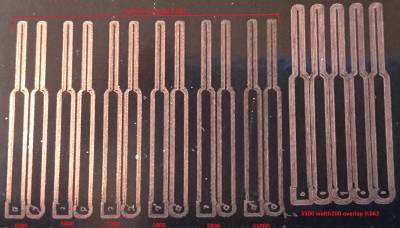 =⇒ 750 mm/minute semble OK , mais le laser met du temps a s'activer et désactiver
=⇒ 750 mm/minute semble OK , mais le laser met du temps a s'activer et désactiver
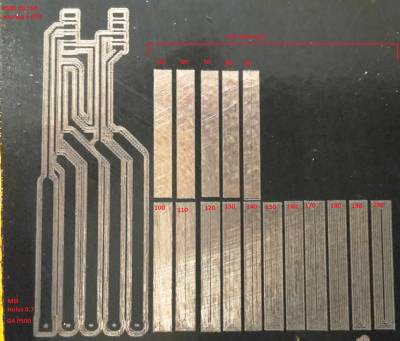 =⇒ diametre du laser autour de 0.12mm
=⇒ diametre du laser autour de 0.12mm
- avoir des piste fine assez large configurer l'outil a un diametre de 0.3mm avec overlap de 60% ou 0.4mm avec overlap de 70%
- le temps d'activation/désactivation du laser est >0 et ⇐100ms
- pour avoir un trou de centrage correcte (0.3mm+(0.24mm dlaser)) configurer une fraise de 0.7mm pour les trou de 1mm
- https://ncviewer.com/ Gcode viewer
- https://marlinfw.org/docs/gcode/G004.html Marlin Gcode
Double Faces
- Ici on mettra le botton à gauche et le pcb top à droite, en tournant le PCB comme une page de livre
- Pour caler l'ensemble j'ai une barre de fer de 4-5mm en bas bien parallèle a X.
- une Tôle plate de 0.4mm a gauche
- une Tôle de 0.4mm plié en L pour faire un axe centrale de 5mm de hauteur.
- importer drl ,top, bottom
- placer le coin bas gauche des différentes couche en 0,0
- Double-Sided PCB Tool
- bottom layer : bottom
- Mirror Axis : Y
- Axis location : Point : 0,0 ⇒ Mirror Object
- découper le contour de 2-3 règles {{ :doc:elec:regle.zip |}}
- re-démarrer la machine (le centrage de la précédente impression sera probablement détruit par l'allumage initial des moteurs)
- décaler d'au moins 10mm en X
- centrer Laser en 0,0 (point miroir) à la machine, finir par pas de 0.1mm
- imprimer les faces bottom et top de la règle de mise au point
- décaler X de 10mm a droite au gauche puis revenir à la moitié de la lecture de la régle
- imprimer TOP
- percer au moins un trou
- imprimer bottom
- pleurer
Autre usage du Laser
- sous inkscape avec le laser tool plugin : http://www.lamaisonsimon.fr/wiki/doku.php?id=doc:elec:elec#inkscape_plugin
- remplacer M106 S255 par M106 S255\n G4 P100
- remplacer M107 par M107\n G4 P100
- découpe de scotche bleu posé sur papier cuisson : vitesse 500 1 passe a 100%
transitor
NPN ou PNP ?
R1
Sinking sensors allow current to flow into the sensor to the voltage common, while sourcing sensors allow current to flow out of the sensor from a positive source. For both of these methods the emphasis is on current flow, not voltage. By using current flow, instead of voltage, many of the electrical noise problems are reduced.
When discussing sourcing and sinking we are referring to the output of the sensor that is acting like a switch. In fact the output of the sensor is normally a transistor, that will act like a switch (with some voltage loss). A PNP transistor is used for the sourcing output, and an NPN transistor is used for the sinking input.
R2
It is confusing, not the least because they use conventional current flow rather than electron flow which reverses the sense of source/sink. It's easiest to think of it in these terms. With a positive supply voltage, a normally biased PNP will have its emitter more positive than its collector. So, a PNP output with an open collector will pull a load positive towards the supply voltage when conducting. This gives what is called a sourcing output. The NPN case is opposite so it's collector will take a load towards ground when conducting. That's why PNP and NPN are sometimes used instead of sourcing/sinking, because they are not ambiguous at least with open collector outputs. Inputs get a little more confusing as some can be strapped to be either sinking or sourcing. In general, a sinking input is one that needs to be pulled up towards the positive supply to be true. And a sourcing input is one that needs to be pulled toward ground to be true. So a Sourcing output would normally be used with a sinking input and vice versa. This all assumes positive logic
R3
An NPN or sinking output accepts voltage and sinks it to ground to complete the circuit. A PNP or sourcing output sources voltage and the external circuit sinks it to ground to complete the circuit. A sourcing circuit would be drawn as voltage→switch→load→ground. A sinking circuit would be drawn as Voltage→load→switch→ground. In these cases, the switch could be a transistor.
Divers
kicad http://kicad. sourceforge.net/wiki/index.php/FR:FAQ

